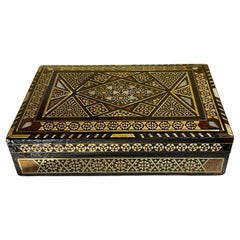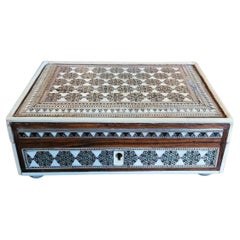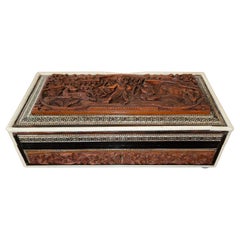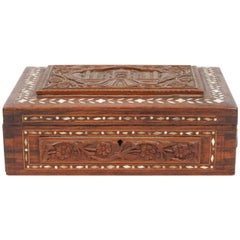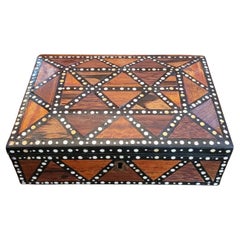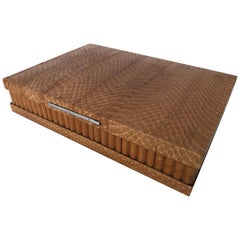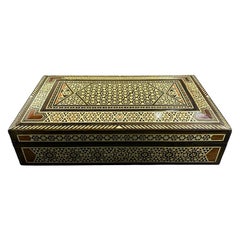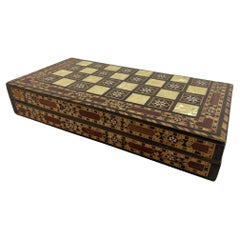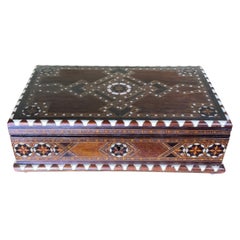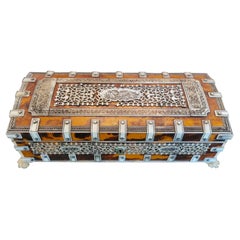Sandalwood Jewelry Boxes
to
9
5
4
3
1
49
1,005
800
326
252
8
1
8
7
6
1
1
Height
to
Width
to
9
9
9
2
Material: Sandalwood
Middle Eastern Moorish Jewelry Box
Located in Delray Beach, FL
exquisite middle Eastern Moorish Syrian inlay jewelry box. This box is intricately inlaid with Moorish motif designs which have been uniquely inlaid with bone, mother of pearl and f...
Category
20th Century Asian Islamic Sandalwood Jewelry Boxes
Materials
Mother-of-Pearl, Sandalwood
19C Anglo Indian Bombay MOP Sadeli Mosaic Trinket Box
Located in Dallas, TX
PRESENTING a LOVELY 19C Anglo Indian Bombay MOP (Mother of Pearl) Sadeli Mosaic Trinket Box from circa 1875-85.
Gorgeously detailed and hand-crafted ‘sadeli mosaic’ inlay, from the Bombay Area, with deep greens with silver, pewter, mother of pearl, bone and ebony in geometric patterns.
The box case, is made of sandalwood but completely covered in MOP, bone, faux ivory, ebony and mosaic inlay.
Edged with faux ivory and banded with a different pattern of sadeli mosaic.
Some minor damage to the top (repair is obvious in pics) and ivorine replacements to some edging, but it still a BEAUTIFUL BOX and of real QUALITY!
The mosaic work is FABULOUS!
Box opens to reveal its original blue velvet lining.
It sits on 4 (recently added) silvered button feet.
SADELI MOSAIC: “Anglo Indian boxes were made in India for the English residents from the early part of the 18th century. They were brought back or sent back to England usually by the people who had commissioned them. From the beginning of the nineteenth century they were imported more commercially, although not in any significant numbers until the middle decades. They were very highly valued, especially the early ones, to the extent that the designs were copied on late 19th and early 20th century tins.
The ancient art of Sadeli Mosaic is said to have been introduced from Shiraz in Persia via Sind to Bombay, a long time before the Anglo Indian boxes were made. It was a technique, which required a high degree of skill and patience. It was executed very lavishly, in that the frequent cuts wasted a great amount of the precious materials used. The workmanship was however more than commensurable to the value of the materials.
Ivory, silver, pewter (or other metals), wood and horn were cut into faceted rods which were bound together to form geometric patterns. When the glue has set, the rods were sliced in transverse sections. This gave the maker a number of angled circular pieces in the original pattern. Several variations of patterns could be achieved by combining the materials in different ways. The ivory was sometimes dyed green to give an extra color.
The mosaic pieces in a combination of patterns, often separated by ivory, ebony, horn or silver stringing were used to veneer sandalwood boxes. In the early boxes, which date from the turn of the 18th to the 19th century, there are large panels of mosaic covering tops and sides of boxes. It took incredible skill to cover such large areas without any shakes or wavering of the pattern. The corners and joins on these boxes are impeccably matched.
The makers (reputed to be Persian) of Sadeli mosaic made in the first two decades of the 19th century displayed a total understanding of the qualities of the different materials they used. They combined substances, which can expand and contract according to atmospheric conditions with others, which are hard and unyielding. The result was a sharp definition of the lines and patterns, which made up the whole design.
On the early boxes the designs look deceptively simple. The fact is, they emerged from a culture, which had mastered geometry and understood how to generate a pattern from a set number of points. The patterns are so harmoniously combined that their incredible complexity is not immediately apparent.
The earliest Sadeli boxes...
Category
Late 19th Century Indian Anglo-Indian Antique Sandalwood Jewelry Boxes
Materials
Silver
19C Anglo Indian Carved Teak Wood and Sadeli Mosaic Box
Located in Dallas, TX
PRESENTING A LOVELY 19th century Anglo-Indian Carved Teak Wood and Sadeli Mosaic Box, featuring a carving of a Hunt Scene.
Made circa 1870 in Bombay, India during the Rule of the Br...
Category
Late 19th Century Indian Anglo-Indian Antique Sandalwood Jewelry Boxes
Materials
Silver, Pewter
19th Century Anglo-Indian Mughal Box
Located in Moreno Valley, CA
19th century Anglo-Indian Mughal wood box, inlaid and hand carved with the Taj Mahal and some flowers all around.
Jewelry box, Anglo-Raj box from India in great condition.
Nice Mughal Bombay Box...
Category
Late 19th Century Indian Anglo Raj Antique Sandalwood Jewelry Boxes
Materials
Sandalwood
19C Anglo Ceylonese Specimen Wood Trinket Box
Located in Dallas, TX
PRESENTING A BEAUTIFUL and RARE 19C Anglo Ceylonese Specimen Wood Trinket Box.
Made in ‘Galle’, Ceylon (now Sri Lanka) circa 1860-80.
Made for the ex...
Category
19th Century Sri Lankan Anglo-Indian Antique Sandalwood Jewelry Boxes
Materials
Bone, Hardwood, Ebony, Sandalwood
Art Deco Python Sandalwood Cigar / jewelry box
Located in Westport, CT
Art Deco python and Channeled sandalwood Mens Cigar / storage box with chrome bar front , felt bottom
Category
Early 20th Century French Art Deco Sandalwood Jewelry Boxes
Materials
Chrome
Large 19th Century Sandalwood Jewellery Box, South India
Located in London, GB
The dense carving of this 19th century South Indian sandalwood jewellery box is so lively and animated.
Category
Late 19th Century Indian Antique Sandalwood Jewelry Boxes
Materials
Sandalwood
Anglo Raj Hand Carved Wooden Decorative Jewelry Box
By Rajhastani
Located in Moreno Valley, CA
Hand carved large wooden Anglo-Raj jewelry box.
Early 20th century wood box richly decorated overall with arabesques and floral carving.
Hinged lid shallow relief carving with inte...
Category
Early 20th Century Indian Anglo Raj Sandalwood Jewelry Boxes
Materials
Sandalwood
Anglo Raj Hand-Carved Wooden Decorative Jewelry Box
By Rajhastani
Located in Moreno Valley, CA
Hand-carved large wooden Anglo-Raj jewelry box.
Early 20th century wood box richly decorated overall with arabesques and floral carving.
Hinged lid shallow relief carving with interi...
Category
Early 20th Century Indian Anglo Raj Sandalwood Jewelry Boxes
Materials
Sandalwood
Related Items
Moroccan Moorish Middle Eastern Large Inlaid Wood Micro Mosaic Jewelry Box
Located in Studio City, CA
Stunning mosaic design, this intricate wood box is made from multiple micro pieces of wood with some possible bone inlays. Gorgeous craftsmanship. A true work of art.
Would be a g...
Category
20th Century Moorish Sandalwood Jewelry Boxes
Materials
Wood
$695
H 2.5 in W 11 in D 6.5 in
Middle Eastern Mosaic Wooden Inlaid Marquetry Box for Game Chess and Backgammon
Located in Moreno Valley, CA
Middle Eastern Mosaic Wooden Inlaid Marquetry Box Game Backgammon and Chess.
Middle Eastern Micro Mosaic Wooden Inlaid Marquetry Box.
Large vintage Moorish Syrian style micro mosaic ...
Category
Mid-20th Century Lebanese Islamic Sandalwood Jewelry Boxes
Materials
Fruitwood
$495
H 2 in W 12 in D 6 in
Large Anglo Indian Mosaic Inlaid Jewelry Hexagonal Box 1950s
Located in Moreno Valley, CA
Large Anglo Indian Moorish Islamic style micro mosaic inlaid jewelry box with lid.
Intricate inlaid Anglo Persian box with floral and geometric Moorish Sadeli design in an hexagonal shape form with micro mosaic marquetry, very fine artwork.
Museum collector piece like the one in Doris Duke Islamic Art Museum.
The repeating geometric patterns of Sadeli Mosaic are what give it beauty and richness.
This decorative technique is a type of micro mosaic featuring repeating geometric patterns.
Dimensions: H: 5 in : 12 in W x 12 in. D.
Circa 1950s.
Sadeli mosaic art is a highly skilled craft, it has had a long history in India and the Middle East with early examples dating back to the 16th century. In the 1800s, it became popular as a decoration on a variety of boxes, card cases, and chess boards imported from India. Since Bombay became a center of making them, they became known as Bombay boxes.
The ancient art of Sadeli Mosaic is said to have been introduced from Shiraz in Persia via Sind to Bombay, a long time before Indian boxes appeared. The designs on early boxes look deceptively simple. The fact is they emerged from a culture which had mastered geometry and understood how to generate a pattern from a set number of points. The patterns are so harmoniously combined that their incredible complexity isn’t immediately apparent to the viewer.
Will look great in a Moroccan decor...
Category
Mid-20th Century Indian Anglo-Indian Sandalwood Jewelry Boxes
Materials
Wood
Lidded Burl Wood Trinket Box by Kreiss
By Kreiss
Located in San Diego, CA
A very nice lidded burl wood trinket box by Kreiss, circa 1980s. The box has a removable lid and is in very good vintage condition; it measures 7"W ...
Category
Late 20th Century American Organic Modern Sandalwood Jewelry Boxes
Materials
Burl
Antique Decorative Middle Eastern Islamic Box 1940s
Located in Moreno Valley, CA
Antique 1940s Mosaic Shell Inlaid Decorative Middle Eastern Islamic Box.
Mosaic Luxury Decorative Middle Eastern Islamic Vanity Box.
Middle Eastern Asian Mosaic Wood Box with Inlays ...
Category
Mid-20th Century Lebanese Moorish Sandalwood Jewelry Boxes
Materials
Bone, Shell, Abalone, Fruitwood
Silvered Art Deco Jewelry Box, Vienna, Around 1920s
Located in Wien, AT
Silvered Art deco Jewelry Box, Vienna, around 1920s.
Polished and stove enameled.
Category
1920s Austrian Art Deco Vintage Sandalwood Jewelry Boxes
Materials
Brass
Micro Mosaic Moorish Inlaid Jewelry Pen Box
Located in Moreno Valley, CA
Micro Mosaic Persian Islamic Moorish Inlaid Jewelry Pen Box.
1950s Middle Eastern Moorish Inlaid Jewelry Trinket Mosaic Box.
Handcrafted mar...
Category
Mid-20th Century Lebanese Moorish Sandalwood Jewelry Boxes
Materials
Fruitwood
Granada Moorish Spain Inlaid Marquetry Jewelry Music Box
Located in Moreno Valley, CA
1950s Moorish Spain Music Box: This exquisite handcrafted box, made in Granada, Spain, showcases the intricate art of Islamic Moorish marquetry. The ...
Category
Mid-20th Century Spanish Islamic Sandalwood Jewelry Boxes
Materials
Fruitwood
1950s Anglo Indian Micro Sadeli Mosaic Inlaid Jewelry Box
Located in Moreno Valley, CA
1950s Anglo Indian Micro Sadeli Mosaic Inlaid Jewelry Box.
DIMENSIONS: 7ʺW × 7ʺD × 2.5ʺH.
Indo Persian Moorish style micro mosaic inlaid jewelry box with lid.
Intricate inlaid Anglo ...
Category
Mid-20th Century Indian Moorish Sandalwood Jewelry Boxes
Materials
Bone, Fruitwood
Vintage Agate Inlaid Moorish Wedding Jewelry Dressing Box
Located in Moreno Valley, CA
Large vintage Moorish wedding jewelry box inlaid with semi-precious agate stones and covered with brass and silvered metal filigree.
Large circular Moorish Middle East jewelry...
Category
20th Century Moroccan Moorish Sandalwood Jewelry Boxes
Materials
Metal, Brass
Moorish Micro Mosaic Inlaid Jewelry Box
By Rajhastani
Located in Moreno Valley, CA
Moorish style micro mosaic marquetry inlaid jewelry box with lid.
Intricate inlaid Anglo Indian box with floral and geometric Islamic
Moorish mosaic Sadeli design in a square shape form with mosaic inlay and marquetry, very fine artwork, lined in red velvet.
Museum collector piece like the one in Doris Duke Islamic Art Museum.
The repeating geometric patterns of Sadeli Mosaic are what give it beauty and richness. This decorative technique is a type of micro mosaic featuring repeating geometric patterns. A highly skilled craft, it has had a long history in India and the Middle East with early examples dating back to the 16th century. In the 1800s, it became popular as a decoration on a variety of boxes, card cases, and chess boards imported from India. Since Bombay became a center of making them, they became known as Bombay boxes...
Category
Mid-20th Century Indian Agra Sandalwood Jewelry Boxes
Materials
Wood
Antique Jewelry Box Art Deco Period
Located in New York, NY
A beautiful antique Art Deco period jewelry box, styled by Jacques Kreisler, circa early-20th Century, New York, New York. Box is an aubergine ...
Category
Early 20th Century Art Deco Sandalwood Jewelry Boxes
Materials
Metal
Previously Available Items
Middle Eastern Moorish Jewelry Box
Located in Delray Beach, FL
exquisite middle Eastern Moorish Syrian inlay jewelry box. This box is intricately inlaid with Moorish motif designs which have been uniquely inlaid with bone, and fruitwood, four br...
Category
20th Century Syrian Islamic Sandalwood Jewelry Boxes
Materials
Mother-of-Pearl, Sandalwood
19th Century Anglo Indian Vizagapatam Shell and Bone Trinket Box
Located in Dallas, TX
PRESENTING A BEAUTIFUL 19th Century Anglo-Indian Vizagapatam Shell and Bone Trinket Box from circa 1880.
Made in Vizagapatam, India.
The box is cons...
Category
19th Century Indian Anglo-Indian Antique Sandalwood Jewelry Boxes
Materials
Bone, Shell, Sandalwood
19th Century Anglo Indian Highly Carved Sandalwood and Sadeli Mosaic Box
Located in Dallas, TX
PRESENTING A VERY NICE 19th century Anglo Indian Highly Carved Sandalwood and Sadeli Mosaic Box.
Late 19th century, circa 1880, Anglo-Indian Box from the “Time of the Raj” made in the Region/Area of Bombay for the British market.
The box is made of sandalwood with highly carved reliefs on all sides depicting various animals (tigers etc) and foliage.
The box is edged in faux ivory/ivorine and ebony stringing and bordered with gorgeous ‘Sadeli Mosaic’ from Bombay.
Sadeli Mosaic is the name given to the type of micro-mosaic used by craftsmen in Bombay, using pewter, silver, green semi-precious stone, bone and ebony to create a geometric type pattern.
Part of our large collection of Anglo-Indian items...
Category
Late 19th Century Indian Anglo-Indian Antique Sandalwood Jewelry Boxes
Materials
Silver, Pewter
Exceptional 19th Century Anglo Indian Sadeli Mosaic Trinket Box
Located in Dallas, TX
PRESENTING A SUPERB AND EXCEPTIONAL EXAMPLE of a mid-19th century Anglo-Indian Sadeli Mosaic Trinket Box.
This one is in BEAUTIFUL CONDITION for its age!
From circa 1850-1860 and made in the Region of Bombay, India for the British market.
The ‘sadeli mosaic’ on this box, is classically an early version, of this type of mosaic work and is ‘coarse’ to the touch. Because of this, most boxes with this type of mosaic, have not survived intact for 170 years, without major losses to the mosaic, from dusting, cleaning, etc.
This box only has only had ONE very minor loss of mosaic to the top, which has been repaired and is hardly noticeable, otherwise it is in GREAT ORIGINAL CONDITION!
The faux ivory banding is even original to the piece.
The ‘Sadeli Mosaic’ on this box is ‘striking’, with gorgeous geometric patterns of silver, pewter, bone, stained bone (green) and ebony.
The box case, itself, is made of sandalwood, but it is completely covered in sadeli mosaic and faux ivory and ebony veneer.
The lid is banded with a different sadeli mosaic pattern.
From circa 1850-60 and made in the Region of Bombay, India for the British market.
The interior is lined in its original red velvet lining.
The box sits on it’s original 4 brass bulbous feet and the red velvet is also on the base underside.
The ‘QUALITY’ of this box is evident from the EXCEPTIONAL Sadeli mosaic work, but also the lock which is an early British ‘Lever’ Lock is a sign of real quality.
This is ONE for the SERIOUS COLLECTOR!
SADELI MOSAIC: “Anglo Indian boxes were made in India for the English residents from the early part of the 18th century. They were brought back or sent back to England usually by the people who had commissioned them. From the beginning of the nineteenth century they were imported more commercially, although not in any significant numbers until the middle decades. They were very highly valued, especially the early ones, to the extent that the designs were copied on late 19th and early 20th century tins.
The ancient art of Sadeli Mosaic is said to have been introduced from Shiraz in Persia via Sind to Bombay, a long time before the Anglo Indian boxes were made. It was a technique, which required a high degree of skill and patience. It was executed very lavishly, in that the frequent cuts wasted a great amount of the precious materials used. The workmanship was however more than commensurable to the value of the materials.
Ivory, silver, pewter (or other metals), wood and horn were cut into faceted rods which were bound together to form geometric patterns. When the glue has set, the rods were sliced in transverse sections. This gave the maker a number of angled circular pieces in the original pattern. Several variations of patterns could be achieved by combining the materials in different ways. The ivory was sometimes dyed green to give an extra color.
The mosaic pieces in a combination of patterns, often separated by ivory, ebony, horn or silver stringing were used to veneer sandalwood boxes. In the early boxes, which date from the turn of the 18th to the 19th century, there are large panels of mosaic covering tops and sides of boxes. It took incredible skill to cover such large areas without any shakes or wavering of the pattern. The corners and joins on these boxes are impeccably matched.
The makers (reputed to be Persian) of Sadeli mosaic made in the first two decades of the 19th century displayed a total understanding of the qualities of the different materials they used. They combined substances, which can expand and contract according to atmospheric conditions with others, which are hard and unyielding. The result was a sharp definition of the lines and patterns, which made up the whole design.
On the early boxes the designs look deceptively simple. The fact is, they emerged from a culture, which had mastered geometry and understood how to generate a pattern from a set number of points. The patterns are so harmoniously combined that their incredible complexity is not immediately apparent.
The earliest Sadeli boxes...
Category
Mid-19th Century Indian Anglo-Indian Antique Sandalwood Jewelry Boxes
Materials
Silver
19C Anglo Indian Vizagapatam Shell and Bone Trinket Box
Located in Dallas, TX
PRESENTING A LOVELY 19C Anglo Indian Vizagapatam T/Shell and Bone Trinket Box.
Made in Vizagapatam, India in circa 1860-1880.
Sandalwood box covered in gloriously patinated blonde shell...
Category
19th Century Indian Anglo-Indian Antique Sandalwood Jewelry Boxes
Materials
Bone, Shell, Sandalwood
Large Damascus Inlaid Mahogany Box
Located in Kenilworth, IL
Damascus inlaid rectangular box with hinged lid and covered with matched geometric hexagonal pattern with diapered border. The inlays are composed of sandalwood and ebony with abalon...
Category
20th Century Sandalwood Jewelry Boxes
Materials
Bone, Abalone, Ebony, Mahogany, Sandalwood
19th Century Anglo-Indian Octagonal Shell and Bone Jewelry Box
Located in Dallas, TX
Presenting an absolutely gorgeous 19th century Anglo-Indian octagonal shell and bone jewelry box.
Made in Colonial India (the Time of the Raj), circa...
Category
Late 19th Century Indian Anglo-Indian Antique Sandalwood Jewelry Boxes
Materials
Bone, Shell, Sandalwood
Anglo Indian Porcupine Quill Box
Located in London, by appointment only
Anglo Indian porcupine quill box.
Category
19th Century Indian Anglo-Indian Antique Sandalwood Jewelry Boxes
Materials
Horn, Sandalwood
Middle Eastern Moorish Mother of Pearl Jewelry Box
Located in Delray Beach, FL
One of a kind, exquisite middle Eastern Moorish Syrian inlay jewelry box. This box is intricately inlaid with Moorish motif designs which have been uniquely inlaid with bone, mother ...
Category
20th Century Islamic Sandalwood Jewelry Boxes
Materials
Mother-of-Pearl, Sandalwood
19th Century Anglo Indian Vizagapatam Miniature Shell and Faux Ivory Ring Box
Located in Dallas, TX
Stunning early 19th century example of a Vizagapatam box.
19th century Anglo Indian Vizagapatam miniature shell and faux ivory ring box.
From cir...
Category
Mid-19th Century Indian Anglo-Indian Antique Sandalwood Jewelry Boxes
Materials
Bone, Shell, Sandalwood
H 2 in W 3.6 in D 2.75 in
19th Century Anglo Indian Vizagapatam Miniature Shell and Bone Ring Box
Located in Dallas, TX
Stunning early to mid-19th century example of an Anglo-Indian Vizagapatam miniature shell and bone ring box of exceptional quality.
From circa 1820-1840.
Made in Vizagapatam, I...
Category
Mid-19th Century Indian Anglo-Indian Antique Sandalwood Jewelry Boxes
Materials
Bone, Shell, Sandalwood
19th Century Anglo Indian Vizagapatam Shell and Faux Ivory Ring Box
Located in Dallas, TX
Stunning mid-19th century example of a Anglo-Indian Vizagapatam ring box of real quality.
From circa 1870.
Made in Vizagapatam, India. The box is made of sandalwood but complet...
Category
Late 19th Century Indian Anglo Raj Antique Sandalwood Jewelry Boxes
Materials
Bone, Shell, Sandalwood
Recently Viewed
View AllMore Ways To Browse
Antique Japanese Lacquer Jewelry Box
Chinese Jewelry Chest
Egyptian Jewlery Box
Gothic Bronze Box
Maitland Smith Ltd
Manning Of Ireland
Music Box 1970
African Wild Dog
Antique Jewellery Display Boxes
Antique Valet Box
Asprey Jewelry Box
Chinese Jade Jewlery Box
Chinese Jewelry Cabinet
Chinese Jewelry Cabinets
Danish Jewelry Teak
Mithe Espelt Jewelry
Musical Jewellery Box Antique
Schlevogt Hoffmann
